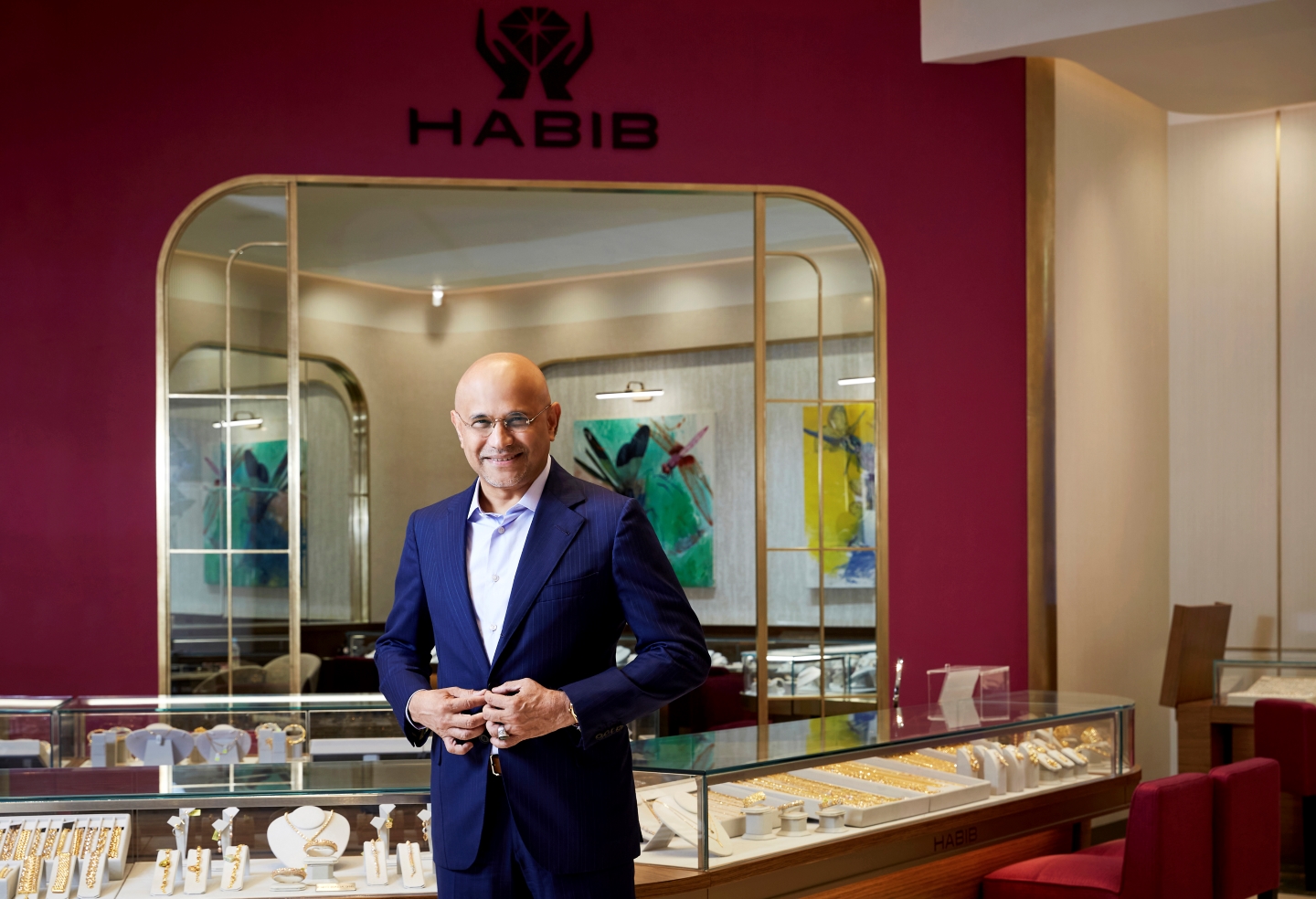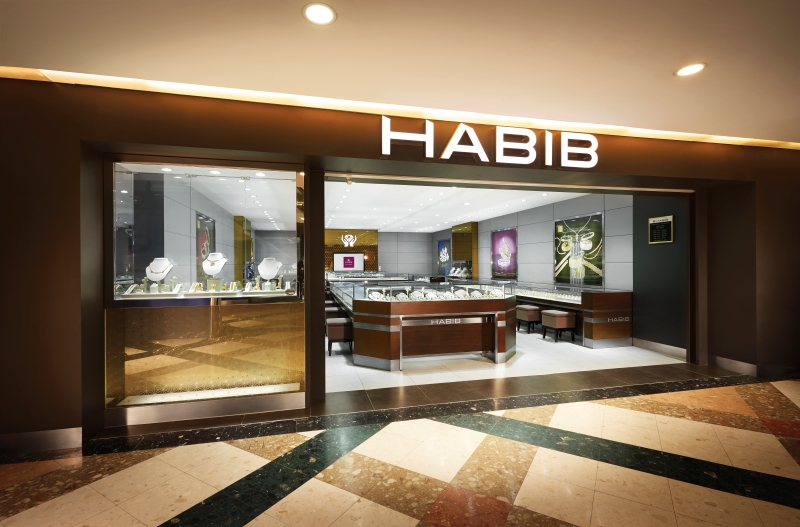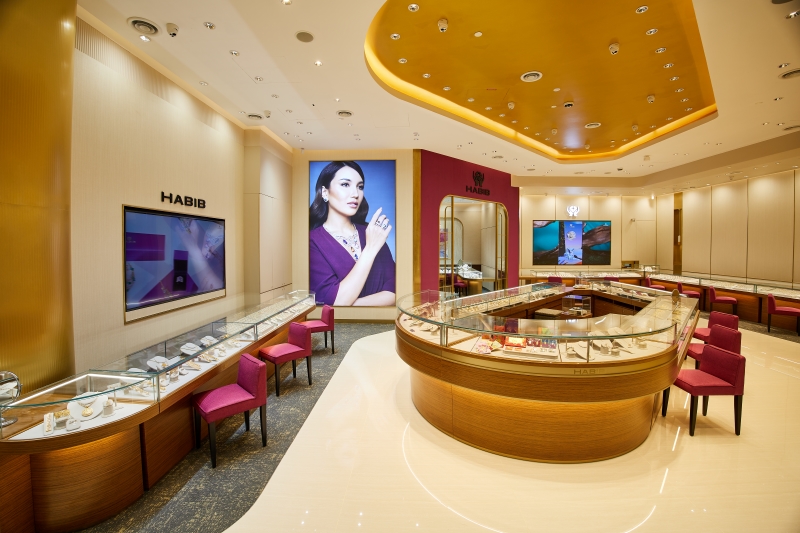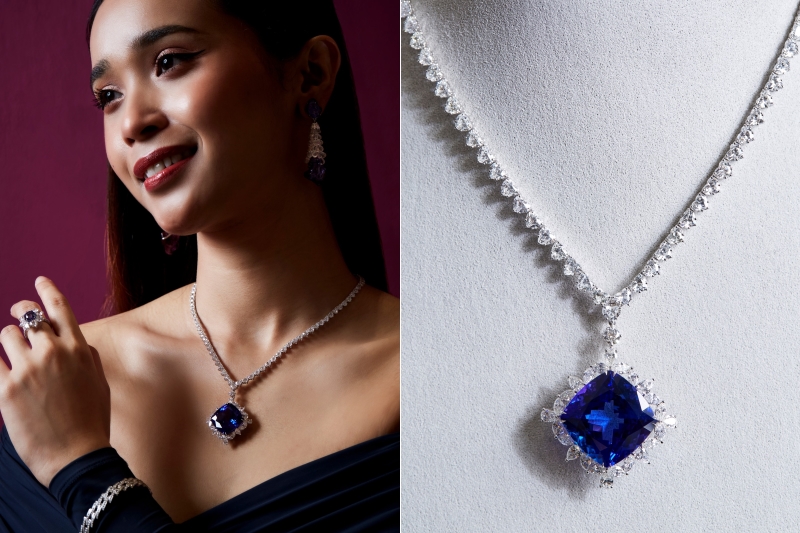
Meer: I hope Habib will be known as the champion of Malaysian brands, bringing world-class quality and putting Malaysia on the map (Photo: SooPhye)
It is a Thursday morning at The Exchange TRX in Tun Razak Exchange, Kuala Lumpur, just as the curtains are about to be drawn close on 2023, and curious mall-goers are milling about, soaking in the window displays that gleam with enticing promises to up one’s aesthetic allure.
Options meets up with Datuk Seri Meer Habib, group executive chairman of Habib, at its new store in KL’s mall du jour to talk about the evolution of the company and the jewellery industry. It is a remarkable narrative about perseverance, innovation, foresight and legacy that spans 66 years.
In the beginning
It all began in 1958 when a young and enterprising Habib Mohamad, Meer’s father, kick-started his career in a jewellery store. Gifted with an innate understanding of genuine customer needs, he ascended the ranks from shop assistant to a participating partner. His entrepreneurial spirit led him to venture out independently, giving birth to the very first jewellery store along Penang’s iconic “jeweller’s corner” on Pitt Street, now known as Jalan Masjid Kapitan Keling.
The late Habib did not merely tread the conventional path, he carved out a unique trajectory for his enterprise from its very inception. In an era dominated by gold, he dared to stand apart by concentrating on diamonds. The company was ahead of the curve.
Having assisted his father in the family business during his formative years after school, Meer went on to graduate from Wichita State University in the US with a degree in business administration and later qualified as a gemologist from the Gemological Institute of America. He then assumed a more active role and contributed to the company’s expansion.
Habib’s first Kuala Lumpur outlet opened at Semua House, Jalan Masjid India, in 1986 and Meer initiated the production of kerongsang, butang baju Melayu and long necklaces. Malaysians lapped up their designs, which were considered an elevation of traditional craftsmanship. The company achieved another milestone in 1998 when it became the first public-listed jeweller. Steering the brand to such heights required not only dedication but also exceptional business acumen on Meer’s part.
habib_semuahouse4441_main-n2.jpg

“Habib Semua House will always have a special place in my heart. It was not only our first outlet in KL but also the very first store to be called Habib Jewels. Before this, our shop in Penang was known as Haji M A Habib Mohamed. We were at Semua House until it closed in 2022, so there were a lot of beautiful memories from those 36 years,” Meer recalls.
“We’ve always prided ourselves on being custodians of keeping arts and heritage alive, so it’s wonderful to see the revival of Semua House. It will be a full-circle-moment reopening there, a true testament of how Habib has progressed into the future.”
The mall, once a popular destination for all wedding needs, is currently undergoing renovation led by architect Shin Tseng, who is known for his expertise in revitalising heritage buildings. It will reopen in March. The mall’s official Facebook page describes it as “... a place brimming with life — a canvas not just for shopping, but for rest, artistic expression and community connections. We’re building more than structures; we’re designing experiences and a place for you to belong”.
“With the reopening of the Semua House outlet, our flagship showroom in Masjid India and 118 Mall (previously known as Merdeka @ 118), we will have a total of 38 active showrooms by end-2025, with more slated to come,” says Meer.
The 118 Mall will be the next important landmark in KL. It is truly a symbolic representation of our history, journey and progress since independence. It is a beacon of Malaysian heritage and modernity that resonates greatly with Habib, he adds.
“Our expansion strategy is mostly based on landmark places where we want to have representation, instead of increasing the number of showrooms aggressively. We always look from the customer’s point of view for what connects them to our identity as Malaysians and is most convenient for their experience.”
img_7012.jpg

Trials + tribulations
While Meer has been strategically expanding his jewellery business, he faces one consistent challenge — securing prime spots at shopping malls. “This has been somewhat disappointing, reflecting the broader issue of local companies often struggling to gain respect and get the favourable locations they rightfully deserve. It appears that regardless of the quality of a brand, international labels tend to be favoured and are given better visibility. This has been my struggle from the beginning and continues to be a hurdle even today,” he laments.
Meer has never shied away from discussing this topic extensively because he believes it originates from a place where certain individuals, and even some nations, grapple with an inferiority complex. “This, I believe, is rooted in a lingering colonial mentality which perpetuates the perception that someone or something from overseas is inherently superior to us. Our endeavour is to showcase Malaysia on the world stage, challenging these notions and asserting our own identity and worth.”
The role of group executive chairman in the jewellery industry comes with its unique set of challenges, and navigating through the highs and lows has been a valuable learning experience for Meer. “At Habib, we embrace an entrepreneurial approach to running our business, recognising the constantly changing consumer expectations. Our ability to seamlessly match entrepreneurship with flexibility and agility has allowed us to swiftly adapt to the dynamic needs of our customers, be it in terms of taste, design or value.”
In the ever-evolving landscape of consumer needs and industry dynamics, maintaining a strong and adaptive presence is crucial. Meer acknowledges that change is constant and to stay ahead, the company amplified its e-commerce efforts during the Covid-19 pandemic so it could still reach its end market.
The current consumer context allows for both online and offline global comparisons. With information readily available, one is forced to be extremely efficient to meet market demands. “If you’re doing something correct, competitors will look at you and follow. We need to keep improving the brand to stay relevant. For e-commerce, our good days are always the ‘double-date’ events such as 11.11 and 12.12, when sales can go up fivefold (or 500%) compared with normal days.”
Recognising that jewellery serves a dual purpose, as adornment and investment, Habib prioritises cultivating a culture of honesty and competency within the organisation. “Building and maintaining trust is paramount as we understand that it forms the foundation of our relationships with people in this unique business domain,” Meer stresses.
“We say Habib is your personal jeweller. It sounds better in Malay: We are jauhari peribadi anda. It comes from this saying, Hanya jauhari mengenal manikam, which translates into: Only a seasoned jeweller can discern the unique qualities and value of gemstones. Instead of focusing on selling, we educate our customers, understand their needs and leave it to them to follow their heart’s desire.”
Another challenge is putting together a great team of people who are competent, to instil the core values of sincerity, flexibility and an entrepreneurial spirit to ensure they provide world-class products and top value to satisfy customer needs. Navigating this intricate balance has proved instrumental in propelling Habib forward in the ever-evolving jewellery market.
habib1.jpg

Leaving a legacy
A jeweller is regarded as a tastemaker for society, and Meer’s passion for gems runs so deep that he pursued certification as a gemologist. He is very passionate about introducing new gemstones to the market and educating his team and customers.
He spreads before us the most dazzling gems our eyes have ever beheld. “This is one of the most expensive gemstones, paraiba, sourced from Brazil. It surpasses the value of diamonds, sapphires, emeralds and rubies. Additionally, this tsavorite from Kenya is renowned for its rich, vibrant green, attributed to the higher vanadium or chromium content in Kenyan stones, compared to those from a recently discovered mine in Tanzania, which are of a lighter shade.”
Like a kid in a candy store, Meer enthusiastically shares his knowledge on the vast array of gems and delights in the unique characteristics and intrinsic value of each. He feels these gemstones were introduced too early in 1997, right smack during the Asian financial crisis. Many people were unaware of them at the time but he was undeterred. Despite Habib’s collection of unusual gemstones gradually increasing in price, he still believes they are undervalued, making them an excellent investment opportunity.
“We constantly keep abreast of trends and focus on research and development to improve our knowledge to be the best in the field. In Malaysia, people often buy jewellery for investment,” says Meer.
Over the past few years, diamonds and other gems have gone through some ups and downs. The introduction of lab-grown diamonds caused a lot of confusion in the beginning and prices of those mined naturally went down as a result. But they have stabilised. Gemstones like ruby, emerald and sapphire have also achieved a level of maturity in terms of pricing.
“I hope Habib will be known as the champion of Malaysian brands, bringing world-class quality and putting the country on the map with jewellery that represents our heritage and culture. We will continue to contribute to the future of jewellery here with continuous research on pieces and designs that reflect Southeast Asia.”
When it comes to passing on the mantle to his children, Meer says he has done his best to provide them good education and instil a positive mindset, the right values, integrity and a strong foundation with principles. “I allow them to explore whatever they want to do, make mistakes and learn from them. So far, I’m quite fortunate to see my kids working very hard to establish themselves in areas they are passionate about.”
Older son Mirzan oversees the Ice-Watch brand as director of Time Zone. Additionally, he is the proprietor of the Vernakular Store in Bangsar, KL, which features a watch gallery and the Peep Coffee café. Mirsham is director of Harta, short for Habib: Action for the Revival of our Traditions and Arts. The 8,000 sq ft space in Ampang Point comprises a heritage jewellery museum, an art gallery and a café. And daughter Marissa is the director of brand development for Forms Jewellery in Hong Kong.
As Meer reflects on his journey and the legacy he hopes to leave behind, his passion for gems and commitment to excellence shine through. This jauhari is undoubtedly a force to be reckoned with.
This article first appeared on Feb 12, 2024 in The Edge Malaysia.


